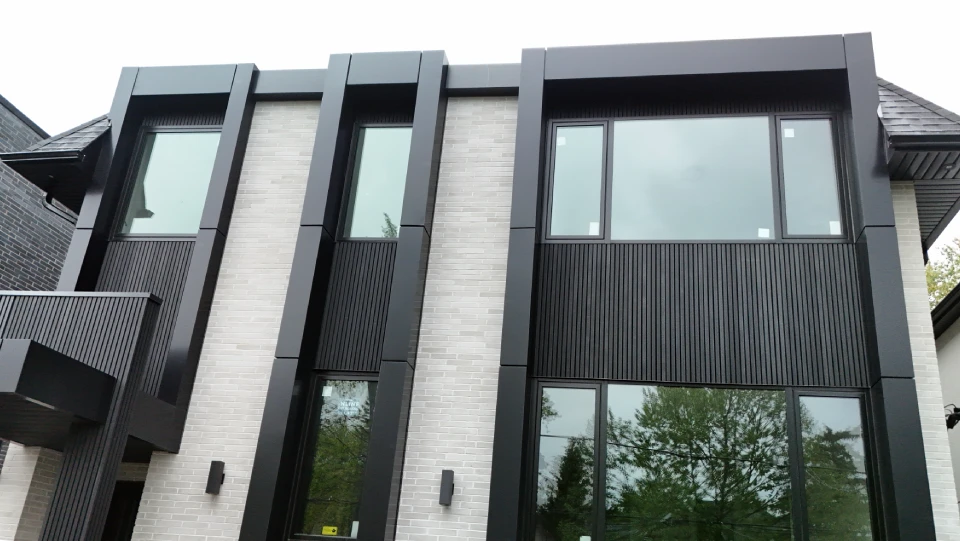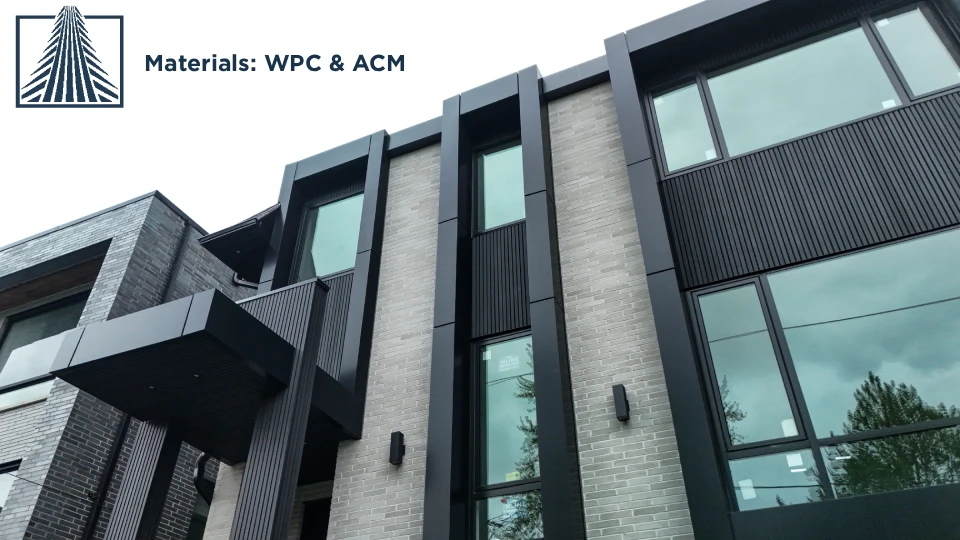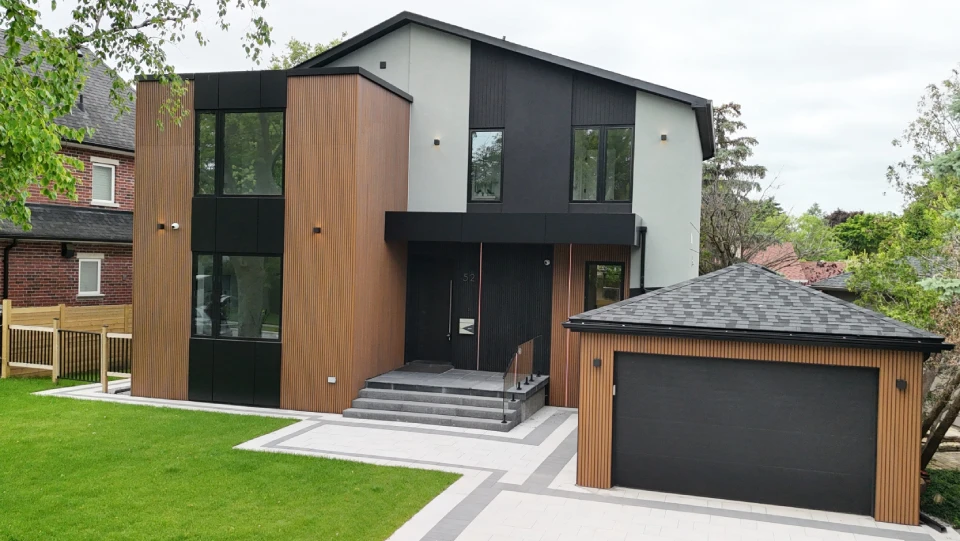WPC fluted panels, also known as Wood Polymer composite fluted panels, have become one of the most popular solutions in modern architecture. Whether you are looking for stylish WPC wall panels or robust cladding for exterior walls, these panels offer a perfect balance of functionality, aesthetics, and durability. In Toronto, the demand for WPC fluted panels is rapidly increasing as homeowners, designers, and contractors search for sustainable and long-lasting alternatives to traditional building materials.
WPC Fluted Panel
A WPC fluted panel is a composite material made from a blend of wood fibers and thermoplastic polymers. This fusion creates a strong, versatile panel that mimics the natural look of wood while offering superior resistance against environmental factors. The fluted design adds depth, texture, and a premium appearance, making it suitable for both residential and commercial applications.
The manufacturing process involves mixing wood flour, recycled plastic, and additives to create a homogenous material. The panels are then extruded into fluted shapes, offering structural stability and unique visual appeal.

Why Choose WPC Fluted Panels Over Traditional Materials?
Traditional materials such as natural wood, stone, or PVC often face limitations. for example: wood rots, stone is heavy, and PVC lacks the premium look. On the other hand, WPC wall panels combine the best of all worlds: the beauty of wood, the durability of plastic, and the strength of engineered composites.
Additionally, WPC fluted panels are environmentally friendly since they often incorporate recycled materials. This makes them an excellent choice for green building projects.
Differences between WPC and natural wood
Advantages of WPC Fluted Panels
The most important advantages of using WPC wall panels are these:
Durability and Longevity
WPC fluted panels are designed to withstand harsh weather conditions, resist cracking, and maintain their integrity for decades without fading or warping.
Water and Moisture Resistance
Unlike natural wood, WPC panels do not absorb water. This makes them ideal for humid areas, exterior walls, and rainy climates like Toronto’s.
Low Maintenance Needs
These panels require minimal upkeep—no painting, sealing, or polishing. Simple cleaning with water is enough to keep them looking new.
Aesthetic Appeal and Versatility
With various colors, textures, and designs, WPC fluted panels can complement both modern and traditional architecture.
Fire Resistance and Safety
WPC panels are engineered with fire-retardant properties, ensuring safety in both residential and commercial projects.
Eco-Friendly and Sustainable Choice
Made from recycled wood fibers and plastics, WPC panels contribute to reducing deforestation and plastic waste.
Applications of WPC Fluted Panels
When we look at WPC fluted panels, we don’t just see decorative cladding; we see a multifunctional material that integrates performance, aesthetics, and durability into the fabric of a building. Their role goes far beyond a simple wall finish; they actively shape the character, comfort, and efficiency of a space.
Let’s explore their main applications the way a designer or engineer would approach them:
Exterior Wall Cladding
One of the most valuable applications of WPC fluted panels is in exterior facades. Unlike natural wood that requires continuous maintenance, WPC panels deliver the warmth and elegance of timber without the risk of warping, fading, or rotting. For architects in Toronto, this means we can specify them confidently for residential facades, commercial towers, or mixed-use developments knowing they’ll hold up against snow, rain, and UV exposure. The fluted texture also adds rhythm and vertical emphasis, making buildings appear taller and more refined.

Interior Design Applications
Inside a building, WPC fluted panels bring an immediate sense of sophistication. They are often used in lobbies, corridors, or feature walls where architects want to make a bold yet timeless statement. The fluted grooves play with light and shadow, creating a dynamic interior that shifts throughout the day. Compared to paint or plaster, WPC wall panels offer depth, acoustic comfort, and a tactile surface that enhances user experience.
Commercial Building Facades
For corporate offices, retail outlets, and hospitality spaces, WPC fluted panels provide both branding and durability. As an architect, I appreciate how they can be customized in finishes to match a brand’s identity—whether that’s a luxurious matte walnut tone for a boutique hotel or a sleek, modern grey for a tech office. Their ability to be installed quickly with concealed systems also minimizes disruption in commercial projects where time is money.
Residential Projects
In residential architecture, WPC fluted panels serve as both a protective skin and a design element. For single-family homes, they are often applied to balconies, terraces, or garden walls where exposure to moisture would normally damage wood. In multi-unit housing or condos, they bring uniformity and a high-end appearance without burdening homeowners with yearly maintenance costs. As a result, they are increasingly chosen by Toronto developers to add long-term value to properties.
Architectural Accents and Hybrid Designs
Beyond their use as cladding, WPC fluted panels are also excellent for accent elements such as column wraps, ceiling treatments, or vertical dividers. Architects often combine them with glass, steel, or stone to strike a balance between modern minimalism and natural warmth. This versatility allows us to break away from monotonous facades and introduce layered, textured designs that stand out while remaining sustainable and cost-effective.
Types of WPC Fluted Panels
For selecting the right WPC fluted panel, an architect doesn’t just look at surface beauty! we consider performance, context, and the architectural story we want the building to tell. Different types of WPC panels are available, each engineered to meet specific design and functional needs. Here’s how they break down:
Standard WPC Wall Panels
These are the most widely used panels, perfect for both interiors and exteriors. They offer a clean, uniform fluted design that architects often use when they want consistency and rhythm across large surfaces. For example, on a residential façade in Toronto, standard panels provide the natural look of timber without the risk of decay, while still keeping the structure sleek and modern.
3D Textured WPC Panels
Unlike standard flat fluted profiles, 3D textured panels introduce depth and shadow play. Architects love them for projects where visual drama and bold geometry are needed—think high-rise lobby walls or the entrance of a luxury retail store. The interplay of light across the textured surface makes these panels look almost sculptural, turning walls into architectural features rather than just boundaries.
Acoustic WPC Panels
These panels combine design with function. They are engineered with sound-absorbing properties, making them ideal for theaters, conference rooms, recording studios, or even luxury condos where noise control is crucial. From an architectural perspective, they solve two problems at once: they refine acoustics while delivering the same natural warmth and modern finish as any other WPC fluted panel.
Customized WPC Fluted Panels
Sometimes, projects demand something unique—a specific color tone, profile size, or texture that standard options can’t offer. In such cases, manufacturers can customize WPC fluted panels to fit the architectural vision. For instance, in Toronto’s competitive real estate market, developers often request custom panels to distinguish their buildings and give them a signature look. Customization allows architects to integrate panels seamlessly into hybrid material palettes, blending them with stone, glass, or metals without aesthetic conflict.
Best Type of WPC Wall Panel for Modern Facade
The best WPC wall panel is one that offers a balance between strength, weather resistance, and design flexibility. Panels with UV protection, fire resistance, and thermal insulation are most recommended for Toronto’s climate.
for reading more about wood cladding options you can check the article.
WPC Fluted Panels Combined with other Materials
WPC panels blend seamlessly with stone, glass, and metal, allowing architects to create hybrid designs. Imagine a stone-clad exterior wall accented with WPC fluted panels, it brings warmth and elegance while keeping costs reasonable.
When combined thoughtfully with other materials, WPC panels elevate both beauty and performance. For example, using them alongside glass panels allows natural light to dominate while the fluted grooves add depth and texture, preventing the design from feeling cold or sterile.
Another remarkable pairing is with aluminum composite panels (ACP). Aluminum brings a sleek, modern, and highly durable surface, while WPC introduces natural warmth and rhythm. Together, they form a synergy; metal offering sharp precision, WPC providing softness and character. This combination is especially powerful in contemporary Toronto architecture, where energy efficiency and modern minimalism often blend with a demand for organic, timeless beauty.
By integrating WPC fluted panels into multi-material compositions, architects can achieve façades and interiors that are not only visually rich but also functionally superior. These creative unions ensure buildings stand out, remain durable, and reflect the artistic essence that architecture is meant to embody.
WPC Fluted Panels in Toronto: Market Overview
Toronto’s climate, with cold winters and humid summers, demands durable building materials. WPC fluted panels meet these needs, offering resistance to snow, rain, and heat without losing their structure or beauty. Contractors and homeowners in Toronto are increasingly choosing WPC fluted panels for long-term value and modern aesthetics.
Features of the Best WPC Fluted Panels in Toronto
- Weatherproof and moisture-resistant
- UV-protected to avoid color fading
- Energy-efficient with thermal insulation properties
- Easy installation with hidden fastening systems
Cost of WPC Fluted Panels in Toronto
The cost depends on size, design, and installation requirements. While initial costs may be higher than PVC, the long-term durability and low maintenance make WPC panels a smart investment for Toronto homeowners.
Tips for Choosing the Right WPC Fluted Panels
When selecting WPC fluted panels in Toronto, ensure they come with quality certifications, UV protection, and installation warranties. Always choose experienced suppliers and certified installers to guarantee long-lasting results.
summary
WPC fluted panels are redefining modern architecture by blending aesthetics with durability. They are eco-friendly, low-maintenance, and adaptable to Toronto’s unique climate, making them an ideal choice for homeowners, builders, and architects. If you’re planning to upgrade your property with stylish yet practical cladding, WPC wall panels are the investment you need.
FAQs
They resist water, pests, and decay while maintaining a wood-like appearance.
Yes, they are engineered to tolerate freezing temperatures and heavy snow.
With proper installation, they can last 20–30 years without major wear.
Absolutely. they are versatile and widely used for facades, interior walls, and ceilings.
Trusted local suppliers and manufacturers specializing in WPC wall panels in Toronto offer certified and weather-resistant products. call us with the numbers on site.


